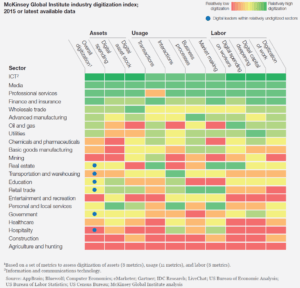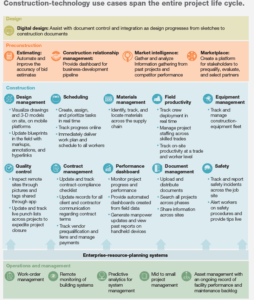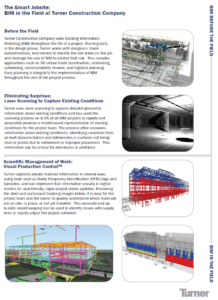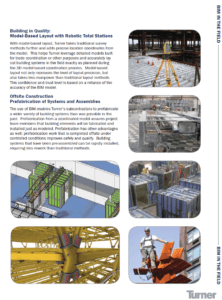Trillions in Wasted Productivity: Digitalization in the Construction Industry

New digital technologies have the potential to exponentially increase productivity in the construction industry. Large companies such as Boston-based Suffolk Construction should begin to adopt these technologies at a faster pace in order to gain a competitive advantage over their peers.
In October 2006, Boston-based Suffolk Construction Company won the bid to build the Torrey Pines Institute for Molecular Studies in Port St. Lucie, Florida.[1] Two years later, in November 2008, the company had completed its work on the 108,000 square foot, $40 million facility. However, a month after completion, Suffolk hired Vico Software, Inc. to answer the question: “could we have done it better?” How could we have harnessed the power of new technological innovations to improve the full supply chain of this construction project?[2]
The Need for Digitalization in Construction
Since the late 1980’s, digital technologies have fundamentally changed the ways in which businesses operate. In developed markets, every sector of the economy has had to adapt to the rapid changes brought on by the applications of digitalization. However, the construction industry remains a late adopter despite the clear potential benefits to digitalization. In fact, while 93% of German construction companies believe that digitalization[*] will influence every single one of their processes,[3] construction remains the second-lowest industry on the McKinsey Global Institute industry digitalization index (see Exhibit 1).
Exhibit 1[4]
Yet, the construction industry is in deep need of meaningful innovation. Global construction labor-productivity growth averaged 1% over the past 20 years (vs. 2.8% in total world economy) and has actually declined in some markets (see Exhibit 2); most large projects face significant cost and time overruns (see Exhibit 3); and construction companies’ R&D and IT spending meaningfully lag that of other industries (<1%).[4]
Exhibit 3[4]
Progress to Date
Despite the slow adoption by construction firms, technology companies have raised approximately $10 billion in investment funding since 2011 to tackle various issues across a construction project life cycle (see Exhibit 4). Use cases have included 3D computer-assisted design, bid estimation, materials supply chain management, and equipment fleet management.[6]
Exhibit 4[6]
One particular improvement has been the concept of Building Information Modeling (BIM). BIM allows construction firms to have a digital simulation of a project before beginning to build, and can also be used interactively to optimize specific steps of a building project. For example, as a result of using BIM, a construction firm may be able to save on material costs by placing relevant orders in bulk and ahead of time, or could optimize labor on a jobsite. The industry has seen meaningful costs savings as a result of using BIM, but remains slow to adopt the additional numerous tools that could further raise its productivity and optimize its cost structure.
Progress at Suffolk Construction Company
As a result of the Vico Software engagement, the Suffolk management team learned ways to significantly enhance their project planning and execution using BIM.[2] In a 2011 presentation, a Suffolk division president detailed some savings the company was able to achieve on a single project through the use of BIM: “all the steel beams…were purchased…with the steel fabricator to beat a price increase and save $650,000… piping and valve assemblies were fabricated off-site, saving over $100,000… Suffolk’s use of BIM… translated into a total savings of 7,949 man-hours, for a total savings of $814,374.”[7] However, while the adoption of BIM represented a step forward for Suffolk, the company does not seem to have made significant additions to its digital toolkit nine years later despite the proliferation of new technologies. Additionally, the company has not indicated an active search for innovative digital solutions to the current issues the industry is facing.
Based on a recent study by Roland Berger[3] and an article by Michael Shomberg, Global VP and GM for Engineering, Construction and Operations industries at SAP[8], I would suggest Suffolk consider some of the following solutions:
- Upgrade its supply software to have materials delivered closer to just in time thereby optimizing capacity utilization for its workers and equipment. Construction workers only dedicate 30% of their time to their principal activity, using the remainder of their time running errands, looking for and transporting materials, cleaning, etc.[3]
- Invest in a skilled labor network. The market for skilled craftsmen and tradesmen is becoming more competitive across the U.S. Investing in a marketplace providing “Uber-like availability” for skilled labor will reduce the amount of costs and time overruns related to labor[8]
- Invest in hardware. Using sensors on a jobsite to gather up-to-date information could help with worker safety as well as reducing unnecessary downtime[8]
Conclusion
Construction accounts for 13% of the world’s GDP and improvements in the sector’s productivity could result in trillions of additional dollars to the world’s economy.[9] As technology companies continue to enter the sector, construction firms that choose to be early adopters of their offerings will likely win market share as a result of their higher productivity. Suffolk should take note and increase its focus on technology-enabled solutions as some of its larger rivals have done (Exhibit 5). (781 words)
Exhibit 5
[*] This paper uses digitization and digitalization interchangeably since most research articles do not differentiate between the two terms and use digitization to explain the use of digital technologies to affect changes to business models.
[1] “Suffolk to build Torrey Pines.” October 17, 2006. South Florida Business Journal.
[2] http://www.vicosoftware.com/community/suffolk-constructions-torrey-pines-project-
[3] Roland Berger GMBH. Digitization in the construction industry. June 2016.
[4] McKinsey & Company. Imagining construction’s digital future. June 2016.
[5] McKinsey & Company. The construction productivity imperative. June 2015.
[6] McKinsey & Company. The new age of engineering and construction technology. July 2017.
[7] https://www.bdcnetwork.com/blog/autodesk-media-days-suffolk-construction%E2%80%99s-bim-story
[8] Michael Shomberg. “How digitization is disrupting construction: strategies forward.” August 25, 2016. Digitalist Magazine by SAP.
[9] McKinsey & Company. Reinventing construction: A route to higher productivity. February 2017.











Thank you for a very interesting article. Generally, I think that we can see today that most digitization solutions are B2C applications. The construction world is mostly B2B, and definitely a lot can be done.
I love the fact that you recommended to invest in solutions that will increase workers’ safety. The construction industry has a high rate of fatal accidents, and I believe that it’s more important than saving money (though less accidents will also save money).
I wonder who will be the leader of the digital transformation in this industry – will it be someone from within it or an outsider?
Awesome post! Having worked in the construction industry before, it’s great to see technology being harnessed to finally increase efficiencies. From my experience, I believe the most drastic improvements can be found during the design phase of a new project. What I mean is for a typical project, say the construction of a new commercial building, the project goes sequentially through three distinct phases:
(1) The architect designs the building concept/aesthetic.
(2) The engineers design the structure of the building and things like HVAC.
(3) Finally, the contractor comes in and builds it.
Problems arise becomes each of the three parties (architect, engineer, and contractor) are different entities with subtlety different incentives. Examples of typical problems may include: the architect’s beautiful rendering didn’t take into account the weight of the facade and the engineer needs to request additional columns as support; the engineer specifies welding of every single joint because it’s easy to implement in a construction drawing and the contractor realizes it’ll take a ridiculous amount of labor to do; or the engineer specifies a beam in a certain location that directly impedes the path of the air condition ducting, causing a massive rework.
Things like BIM help solve these problems because all these details can be seen in a 3D model by all three parties, allowing them to work together. However, the contracts need to be changed in order for each group to be incentived enough to actually incorporate these improvements rather than continuing the traditional path of separating responsibility, that has been followed forever in construction.
Very interesting topic – although funding for real estate startups has been increasing, most of the attention has been dedicated towards post-construction stage, offering tools for commercializing and managing buildings or apartments [1]. One of the promising avenues for disruption in the sector is the reduction in costs for owning the construction tools – the main consequence of this trend is the potential for democratization of construction through 3D printing and CNC technologies. Those developments have the potential to completely change the power dynamics of the industry [2].
[1] Glasner, J. [2017], “VC doors are wide open for real estate startups”. Techcrunch. Available at https://techcrunch.com/2017/08/26/vc-doors-are-wide-open-for-real-estate-startups/ (Accessed: 29 November 2017).
[2] Parvin, A. (2013). Alastair Parvin: Architecture for the people by the people [Video file]. Retrieved from https://www.ted.com/talks/alastair_parvin_architecture_for_the_people_by_the_people (Accessed: 29 November 2017).
Great article! You raise some great questions as to why the implementation of digitization in construction has been so slow. It’s confusing as to why it is so low on the priority list, but I believe that the slow pace of implementation is exasperated by the workers themselves. In my work with skilled laborers in construction in the oil and gas industry, construction workers are precise and resistant to changing the methodologies that have allowed them to be successful. I believe consistency in implementation and alignment of incentives of the ground employees will be key. As is described in one of your references [[3] Roland Berger GMBH. Digitization in the construction industry. June 2016.], very few employees have access to the tablets that they need to implement this new technology. I believe if construction companies are serious about digitization, these tablets should be required and employees should see some of the savings from the program. I feel better incentives from the employee perspective is the only way to really get digitization off the ground in construction.
I agree with the untapped potential of using technology to enhance how business is done in the construction industry. The market is huge, the operation is complex and the information flow to manage a project is crucial to its success. Your article clearly explains the current situation in this market: despite its impact on other industries, the digital transformation is still a promise in this market.
Your suggestion to the Suffolk Construction Company is aligned with the idea that this company should improve its operation using technology-enabled products, but it also assumes that the team is open-minded and willing to change the way they have been operating for many years. Although they have been experimenting with BMI technology, this is not an evidence that they are willing to take the usage of technology to the next level.
In my point of view, cultural issues and barriers to change operations are the root causes of the low adoption of technology in this industry. Increase in technology adoption in this industry will come from startups with an end-to-end technology-based solution [1]. This way, a construction company can have technology embedded in its DNA and take the most of it.
[1] https://www.xconomy.com/san-francisco/2017/04/17/former-flextronics-tesla-ceo-aims-to-disrupt-construction-industry/
A very thought-provoking article! Rarely do you see major headlines aiming to address how technology could resolve challenges in the very manual construction industry. I would be interested to better understand the entire value chain for construction projects and which components of that chain are experiencing breakdowns that drive cost and time overruns. Are these projects able to consolidate suppliers and invest in shared systems that could streamline order fulfillment based on project timelines and raw material demands ? Are the necessary raw material quality control systems in place to ensure delivery of the right materials?
Thanks for this thought-provoking bit! When we think of automation, the construction industry rarely comes to mind. But, given the short supply of skilled labor and craftsmen, the industry is ripe for automation & digitalization. The ideas about BIM and “Uber for Labor” might be groundbreaking and might improve both the time and cost required for construction. Given the inevitability of these innovations in the construction industry and resulting efficiencies leaves me with the question of what might this mean for real estate as an asset class. Will lower costs and shorter lead times result in erosion of wealth for people who hold most of their net-worth in real estate?